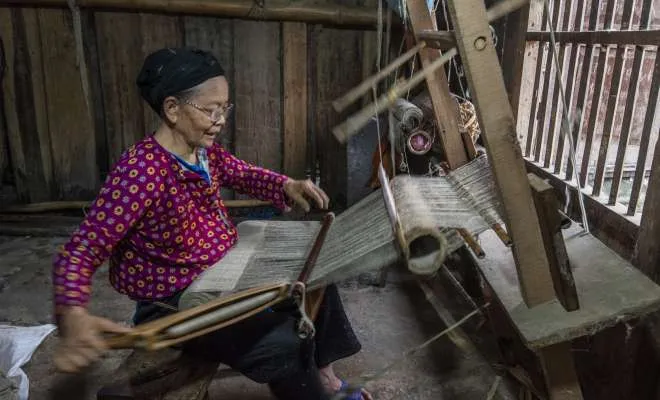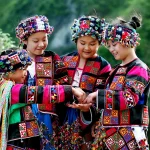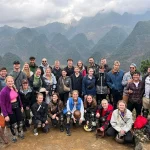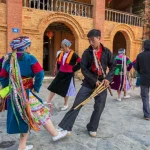Hemp in Ha Giang is not only a simple crop but also carries profound cultural and historical values in the land of Ha Giang. Since ancient times, hemp has become an indispensable part of the lives of people here, especially the H’Mong community. In this article, Karst Plateau will take you on a journey to learn about hemp, from its origin, growing, and processing processes to the unique products created from the plant, and discovering traditional arts. The system is closely associated with the cultural life of the Ha Giang people.
1. History of hemp growing and processing in Ha Giang

Processing of Hemp in Ha Giang has a long history
The origin of hemp
Hemp is an ancient crop, native to East Asia and widely grown around the world. Hemp in Ha Giang is grown mainly in ethnic minority communities, where it is not only an important source of raw materials but also carries profound cultural value. Hemp was once the main raw material for textile production in Vietnam, especially in previous centuries. Traditional clothes woven from hemp fibers not only bring beauty but are also highly durable, and suitable for the harsh climate in the mountains.
Despite many changes, hemp in Ha Giang still holds an important position in the cultural life of the people here. Products made from hemp not only meet consumer needs but also carry spiritual and emotional value, demonstrating the connection between people and nature.
Cultural importance
Hemp is not only a simple agricultural crop but also a symbol of culture and tradition in Ha Giang. In addition, Hemp in Ha Giang is the main purpose of weaving fabric and is also a material used by the H’Mong people in most customs and beliefs. According to the H’Mong people’s belief, the hemp plant has eternal vitality, so they use hemp to tie it with the hope that their house will be sustainable.
Hemp cultivation and processing also demonstrate the ingenuity and talent of the women in the community. They pass down processing experiences through many generations, helping to preserve and promote unique cultural values. During the processing journey, they not only create beautiful products but also convey thousands of years of cultural values.
Long tradition

Hemp in Ha Giang has been closely associated with people’s lives for many generations
Traditions surrounding hemp growing and processing in Ha Giang are diverse. For many generations, Hemp in Ha Giang has played an important role in the daily lives and activities of local ethnic groups, especially the H’Mong people. The traditions involved in growing hemp demonstrate not only the agricultural skills of the local people but also their deep respect for nature and its resources.
Traditional arts: The H’Mong people have developed unique traditional weaving techniques, creating products with strong cultural imprints.
Handmade products: From skillful female artisans, hemp products are handwoven, sophisticated, and delicate, demonstrating the creative capacity and patience of the women in the community.
Conservation value: Hemp growing and processing is not simply about making products but also a way to maintain and promote national cultural identity. Products made from hemp, such as tablecloths, bags, or traditional costumes, all carry stories about their homeland and the lives of the people here.
2. Hemp growing and processing process
The process of growing and processing hemp in Ha Giang is not only a profession but also an art. Each step in this process needs to be meticulous, and careful and is an expression of national cultural pride. Farmers here often start growing hemp during the rainy season, when the soil has high humidity and is suitable for plant growth.
Growing hemp
The process of growing hemp in Ha Giang is simply sowing seeds, but to have a bumper crop, farmers need to clearly understand environmental factors, from soil pH to amount of light sun. Hemp in Ha Giang is usually sown in the spring, with careful care periods to ensure the plant grows well.
Harvest

Harvest of Hemp in Ha Giang is in the summer
Summer is also the time to harvest hemp. Everyone will go to the fields together and divide the work: young people and women will take on the responsibility of cutting hemp, younger children will be responsible for collecting plants, and the elderly will sit and do the remaining steps such as stripping leaves, gathered into bundles.
After harvesting, the hemp in Ha Giang is tied into large bundles and brought home to prepare for drying. The harvested hemp plant is dried (sun and dew) until it turns yellow brown.
Hemp processing
After the hemp in Ha Giang has been exposed to enough sun and dew, it will come to the fiber stripping stage. But this work must be done before the northeast monsoon arrives, otherwise the hemp will dry out. Because this will reduce the durability of hemp, the fibers will be crushed and difficult to join.
Splicing is one of the most time-consuming steps. The hemp fibers, after being stripped relatively evenly, are joined together. When splicing yarn, one must follow the principle of connecting tip to tip, connecting root end to root end, the fibers must be even with each other, then when the fibers are put on the fabric, the fibers will be even and the woven fabric will be flat and smooth. Splicing can be done anywhere in your free time. You can do it at home while looking after your younger siblings or working in the fields, fetching water, etc.
At this time, the fiber has changed from the flat and thin form of tree bark to the round and twisted form of the fiber. The H’Mong people will carry out the rolling process to make the fiber soft, shiny, and the fiber connectors thin and flat, no exposed joints.
Weaving fabric

The weaving process requires high skill and meticulousness
Weaving is a process that requires meticulousness and skill from the worker. Many people evaluate that the H’Mong people on the Dong Van Karst plateau – Ha Giang have a linen weaving technique that is difficult to match anywhere else. Weavers are often mothers and grandmothers because they have the most experience.
H’Mong people weave cloth on simple looms, with only two wooden sticks. Between these two wooden bars, there are four smaller horizontal bars joined to two vertical bars to form a loom and a rather large weaving shuttle. When weaving, people tie them to the pillars of the house and the weaver sits on a chair.
Fabric dyeing
After weaving, the fabric will have a deep, slightly brown color. If the fabric is woven to be beautiful and white, it must be bleached with kitchen ash many times like bleaching fibers. Depending on the needs of the product, there will be different levels of fabric bleaching.
The colors of linen are all natural dyes. The yellow color of turmeric root, the green color of indigo leaves, the purple color of camphor leaves, the deep brown color of brown roots, the reddish pink color of succulents, the color of guava leaves, banana leaves, pandan leaves or other strange leaves in the forest, of pieces of wood bark, etc., all mixed, dyed and dried by the hands of skillful workers on beautiful sunny days in Ha Giang land.
3. Hemp products
Products of hemp in Ha Giang are not only diverse but also imbued with local cultural identity. Ha Giang people have taken full advantage of the value of hemp to produce many useful products for daily life.

Carrying bags woven from hemp in Ha Giang are not only durable and beautiful but also environmentally friendly
Traditional costumes
The fabric of hemp in Ha Giang is often used by H’Mong people to weave traditional costumes. With elaborately embroidered patterns, these costumes are not only beautiful but also contain many cultural meanings. Today, with the development of textile art, hemp products are also becoming more diverse and richer. Hemp woven dresses and shirts are not only products that serve consumer needs but also become works of art that attract all eyes.
Daily items
Hemp in Ha Giang is not only used in garment products but is also actively involved in the production of daily items.
- Carrying bags and handkerchiefs: Carrying bags woven from hemp are not only durable and beautiful but also environmentally friendly, becoming increasingly popular.
- Interior products: In addition, in Ha Giang, people also use hemp fiber to produce interior decoration products such as carpets and curtains. These products are not only highly artistic but also contain unique cultural values of the H’Mong people.
Cosmetics and food
Hemp oil is extracted from the seeds and is known as a nutritious nutritional ingredient, rich in Omega-3 and Omega-6 fatty acids. In many stores, you will find products such as lotions and nutritional supplements made from hemp seed oil, which help improve the health of users.
Paper from hemp fiber: The production of paper from hemp is increasingly popular thanks to its durability and ease of decomposition, towards the goal of sustainable development.
4. Experience hemp crafts in Ha Giang

Craft villages in Ha Giang are where you can see people working with hemp
Ha Giang is the ideal destination to engage in hemp craft experience. Visitors not only get to explore the beauty of the mountains but also have the opportunity to directly participate in the traditional product processing processes of the H’Mong people.
Local market
The local market in Ha Giang is not only a place to exchange goods but also a place to preserve unique cultural values. The markets usually take place on weekends attracting many locals and foreign tourists, where you will find many products of hemp in Ha Giang.
Practical experience
Visitors can participate in traditional activities such as weaving, shopping for hemp products, and gain a deeper sense of the culture and customs of the H’Mong people.
Craft village
The hemp weaving craft village in Ha Giang is an interesting experience that you cannot miss. Here, visitors will receive detailed instructions on each step, from preparing seeds to dyeing and weaving into products. Besides, you will have local people share stories about crafts, helping you see the connection between people nature, and culture.
Tours and workshops
Many professional tour organizers in Ha Giang have exploited the need to explore handicrafts, bringing visitors practical and useful experiences. Tours usually last from 2 to 3 days, including participating in weaving workshops, exploring traditional craft villages, and experiencing cultural activities. Here, the enthusiastic tour guides who understand local culture will help you have an interesting and meaningful journey of discovery.
It can be understood that hemp in Ha Giang is not simply a crop but also a symbol of traditional cultural and artistic heritage. Hemp growing and processing is closely linked to the spiritual and economic life of the Hmong community. From traditional textiles to modern applications, hemp contributes to educating the younger generation about the cultural values and traditions of their homeland. For more information and travel tips in Ha Giang, please visit the Karst Plateau website.














